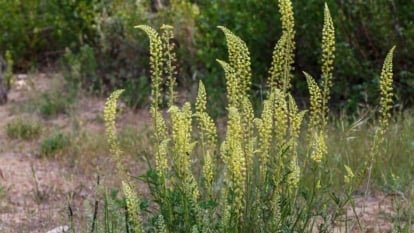Perhaps you’ve carefully designed the landscaping around your house, and now you’re wondering, what should I plant around the pool? You’re probably planning on a lot of poolside chillin’, so choosing the appropriate plants is crucial. Some pool owners love tropical plants, while others are just looking for something that provides shade. Others are hoping to find any plant that will help repel mosquitos.
Plus, your choices are going to be growing near a body of water: your pool. It’s important to consider whether or not they’ll appreciate the extra moisture from the occasional splash.
Wherever you live, there are tons of options. We’ve assembled some of the best plants to grow around the pool.
Japanese Banana Tree
If you’re looking for something tropical to add to your pool area, you can’t go wrong with this cold-hardy banana tree. Even growers in hardiness zones as low as 5 can grow this species, also known as “basjoo banana.” This tree may die back in winter, depending on how cold it gets, but it will return each spring.
Growing a Japanese banana tree isn’t difficult. They’re surprisingly adaptable, flourishing in both full sun and partial shade. Plant them in well-draining soil and amend it with some compost each spring. Don’t let the soil dry out too much, as these banana trees prefer consistent moisture.
In zones 5 through 8, this species will need some help once the first frost begins to damage its leaves. Simply cut the tree back to about two feet tall and mulch around the base to protect its roots. An offshoot will sprout in spring to act as your new banana tree.
Star Jasmine
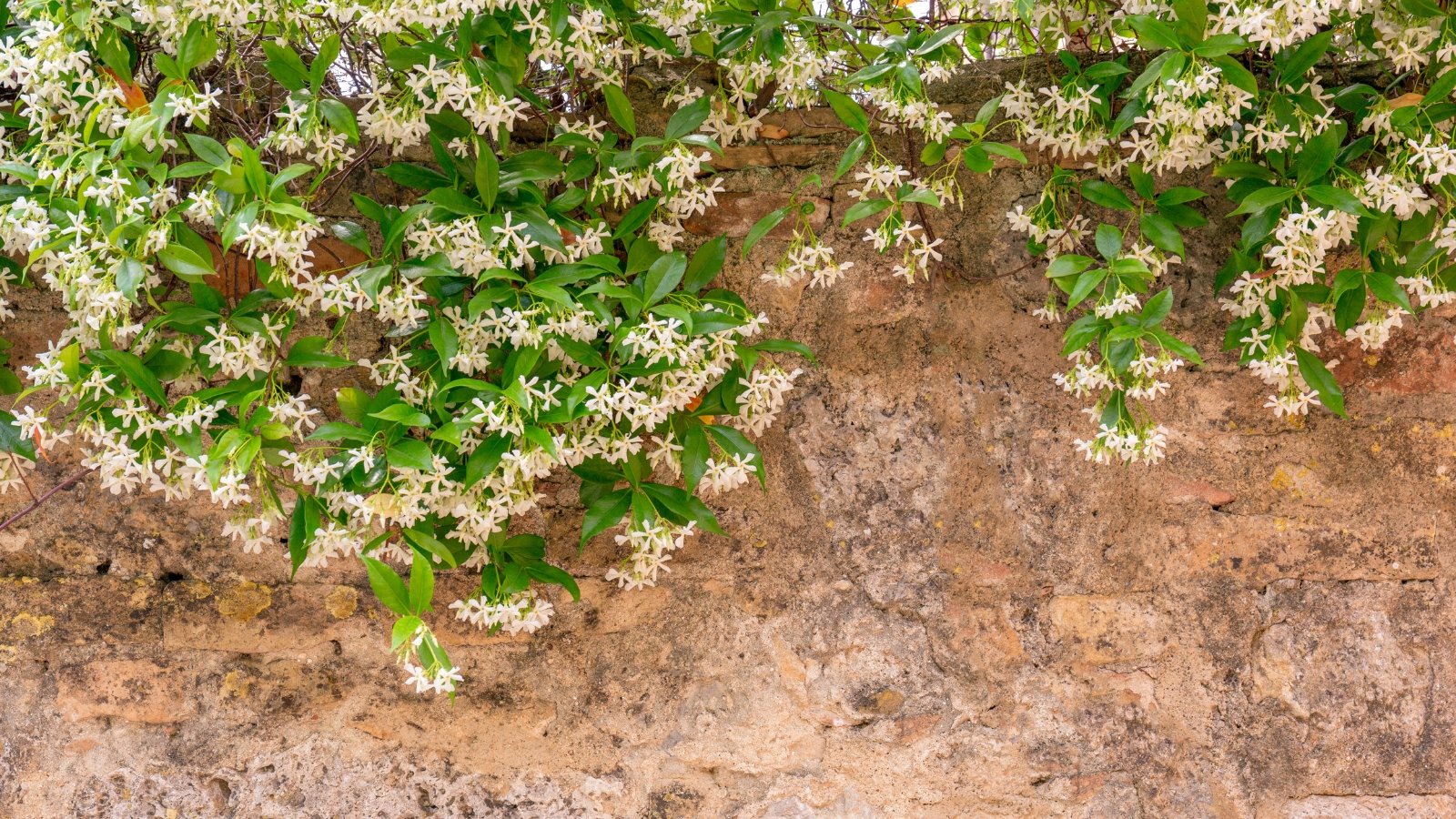
Star jasmine is an excellent climbing perennial to grow around your pool. Its growth habit can provide shade and even a privacy wall. Plus, you’re sure to enjoy the signature sweet scent of its flowers while you swim or bask.
This plant tolerates a variety of conditions, needing only partial shade and still surviving in full shade. Star jasmine will get by in multiple soil types too, from moist to slightly dry. This perennial is even unphased by salt, so it won’t mind a little splashing from a saltwater pool.
Star jasmine is only perennial down to zone 7, but pool owners in cooler regions can still grow it as an annual. Consider decorating with a big pot of star jasmine by the pool, if for no other reason than its lovely fragrance.
Bird of Paradise
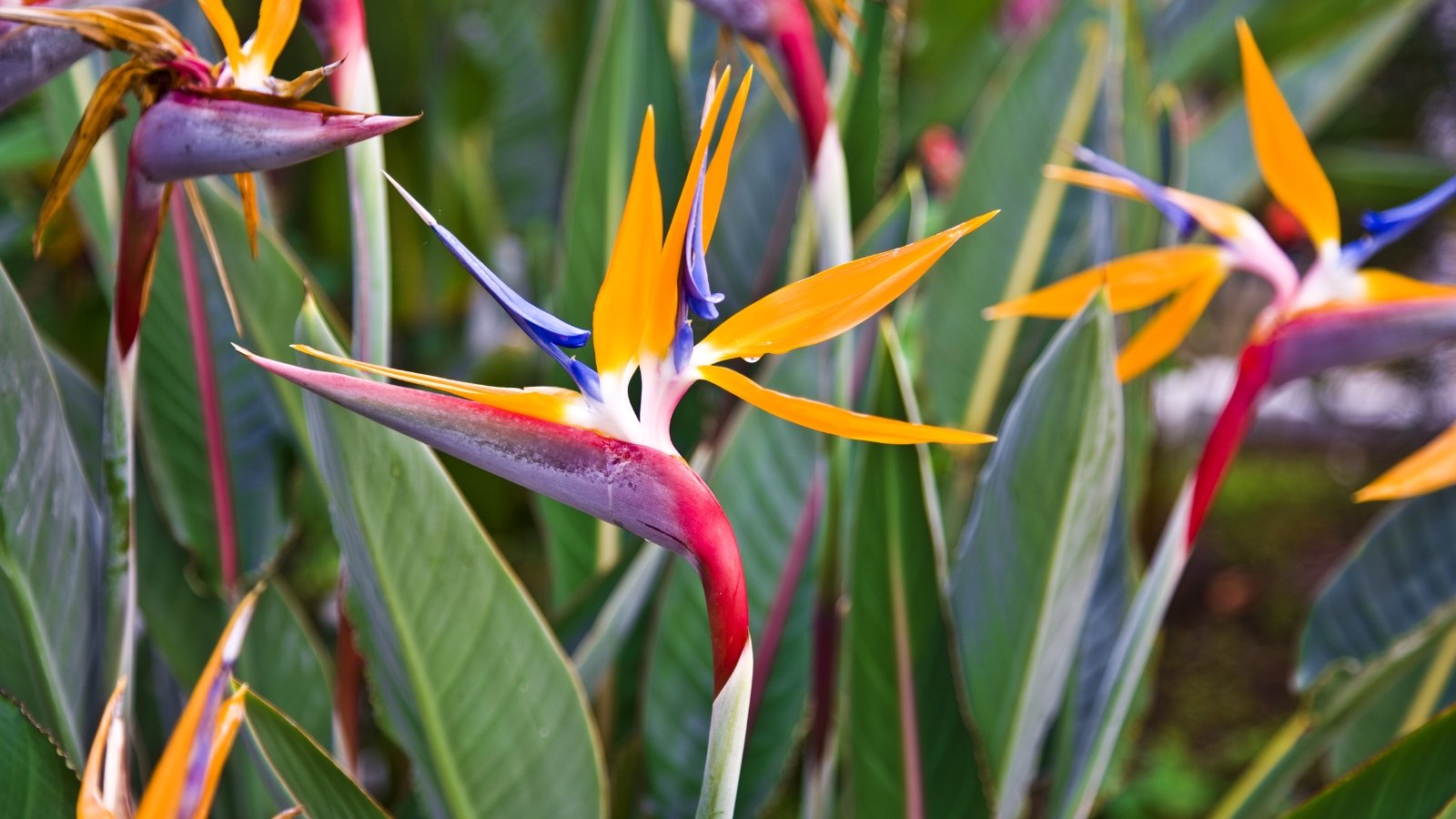
Bird of paradise is a clumping tropical plant with gorgeous, bird-like flowers that inspired its name. If you’re in zones 10 through 12, you can grow this all year as an evergreen. Elsewhere, bird of paradise is a popular houseplant that you can wheel out to the pool each summer.
This plant likes plenty of sunlight, so plant it in full or partial sun. As a houseplant, keep your bird of paradise near the brightest window in your home or supplement, with grow lights to help it flourish. Plant it in fertile, well-draining soil.
Bird of paradise plants should bloom readily outdoors, but blooming can be a challenge when grown as a houseplant. Focus on the ideal light conditions, consistent moisture, and regular fertilization if you want your mostly-indoor bird of paradise to bloom.
Agave
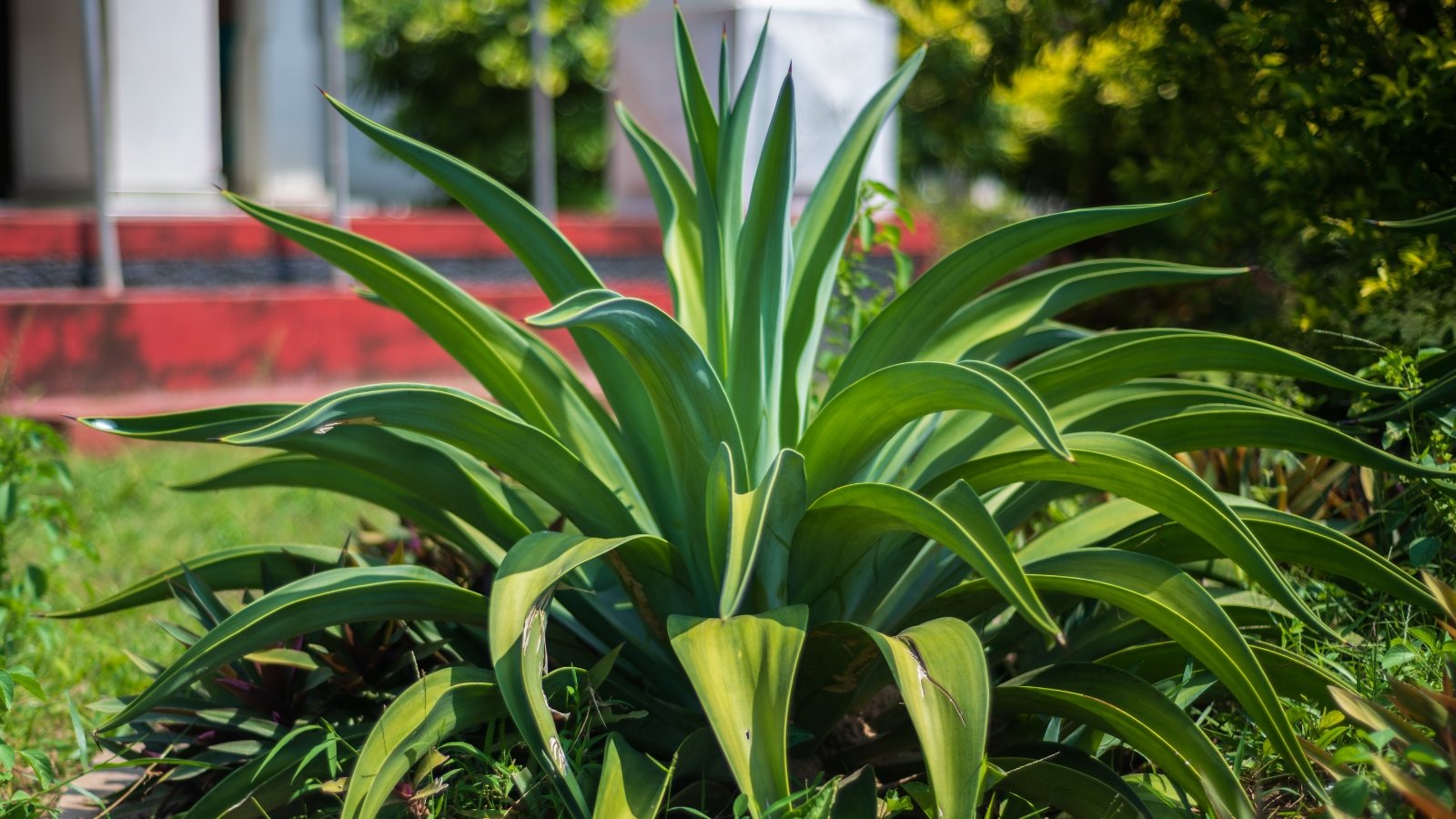
There are tons of species in the Agave genus, and they’re mostly all excellent choices for planting near the pool in hotter, dryer zones. These striking plants are available in many sizes and with different colored leaves, including variegated varieties.
Agave plants have thick, succulent leaves with a somewhat waxy coating. This coating will protect an Agave from any chlorine or saltwater splashed in its direction. They’re also tolerant of intense, full sunlight, so you can place them even in the harshest exposures.
These succulents prefer dry, desert-like soils, so only plant them in extremely well-draining soils. Don’t plant them too close to the pool, where water will moisten the soil. They’re ideal for a xeriscape garden patch. You could even set up a small succulent garden with an Agave as its centerpiece.
Hibiscus
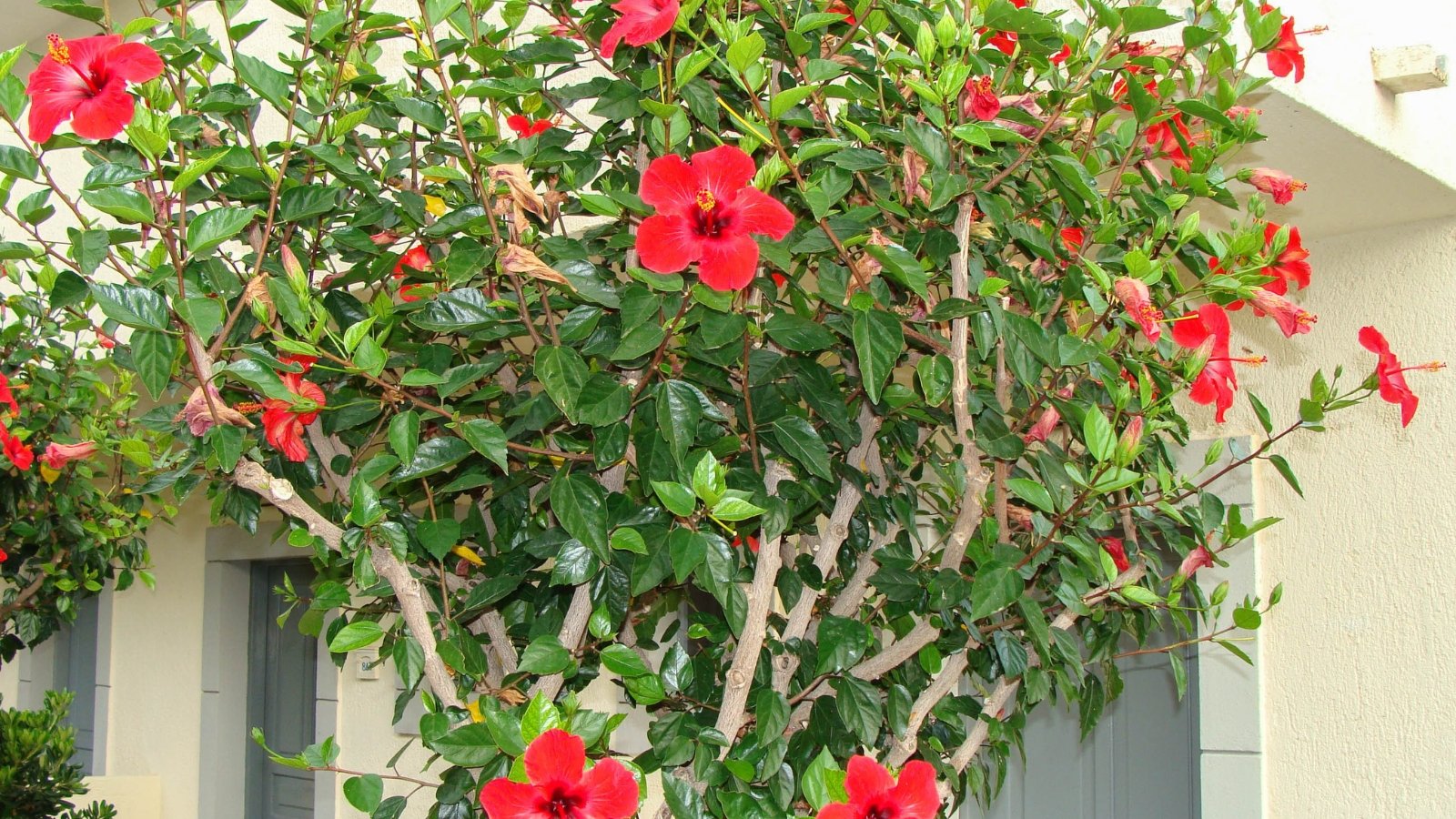
Is there any plant that says “tropical” more than hibiscus? This large shrub can grow up to ten feet tall, with big, gorgeous flowers that are guaranteed to cheer up your pool area. The flowers also have a lengthy bloom season, present from spring through fall.
When planting hibiscus, don’t forget how big it will get. These shrubs not only get up to ten feet tall but also can grow to eight feet wide. In fact, you could plant a few hibiscus shrubs to build a privacy fence around the pool.
Hibiscus prefers at least six hours of direct sunlight per day, and it grows best in moist but well-draining soil. Fertilize your hibiscus plants regularly during spring and summer, and they will continue to dazzle with flowers available in shades of gold, pink, red, and white.
Angel’s Trumpet
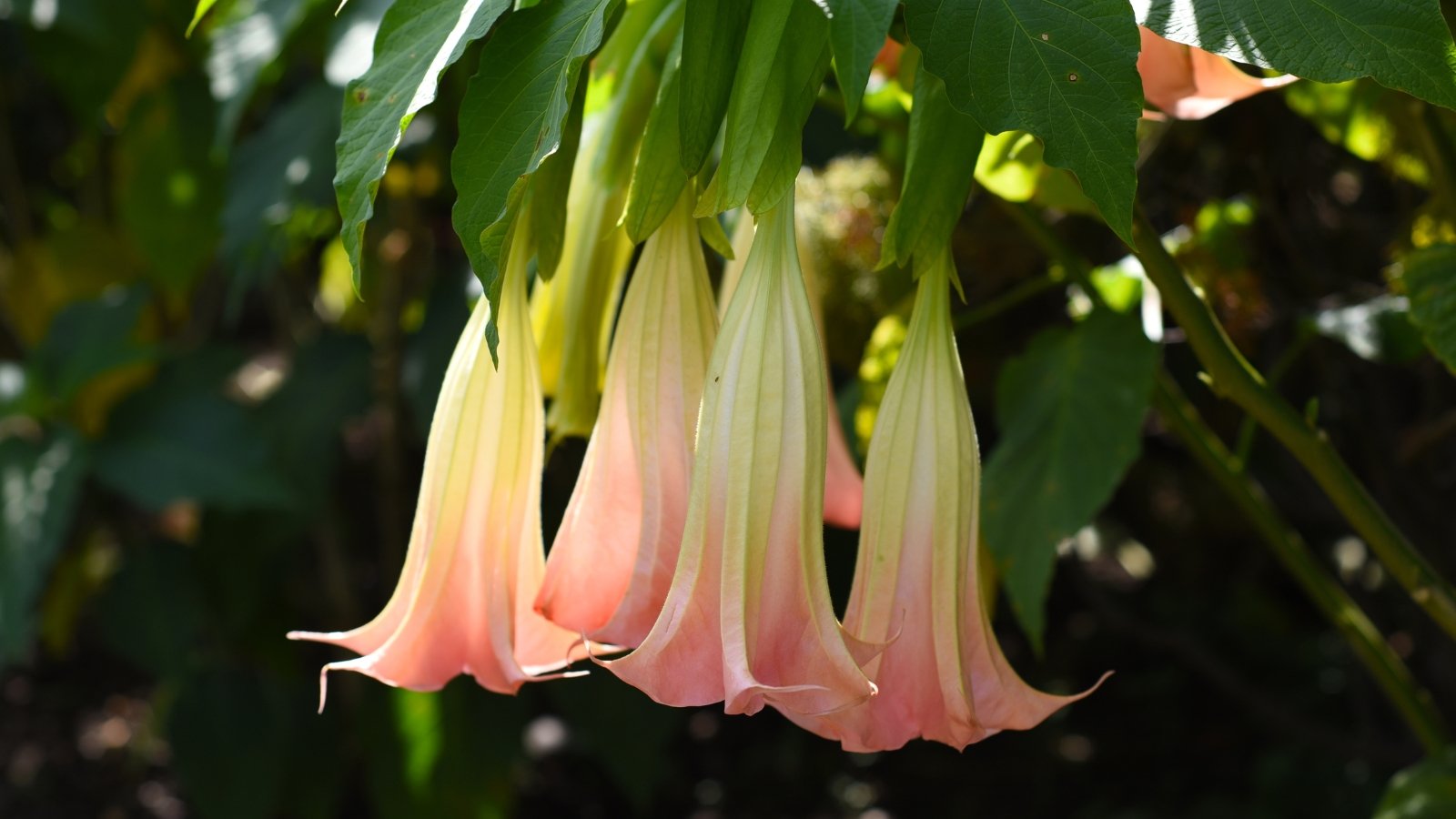
Angel’s trumpet refers to multiple species that form evergreen shrubs or small trees, and they’re often planted near pools. They’re ideal for areas that receive a lot of pool water runoff because these plants prefer moist soils and tolerate chlorine.
You can grow angel’s trumpet directly in the ground or in containers in cooler areas. These plants have beautiful, hanging flowers that can be yellow, pink, or white. When planting angel’s trumpet in perennial zones, keep in mind that these plants can grow up to 35 feet tall with time.
When choosing a spot, opt for one that gets a little bit of shade. Angel’s trumpet does like lots of sunlight, but if planted in a location of true, uninterrupted light, it will wilt. Mostly sun with a few hours of shade is ideal.
Note: Angel’s trumpet is toxic, so keep children and pets away. Growing it slightly off the border of the pool is a good idea too.
Zebra Grass
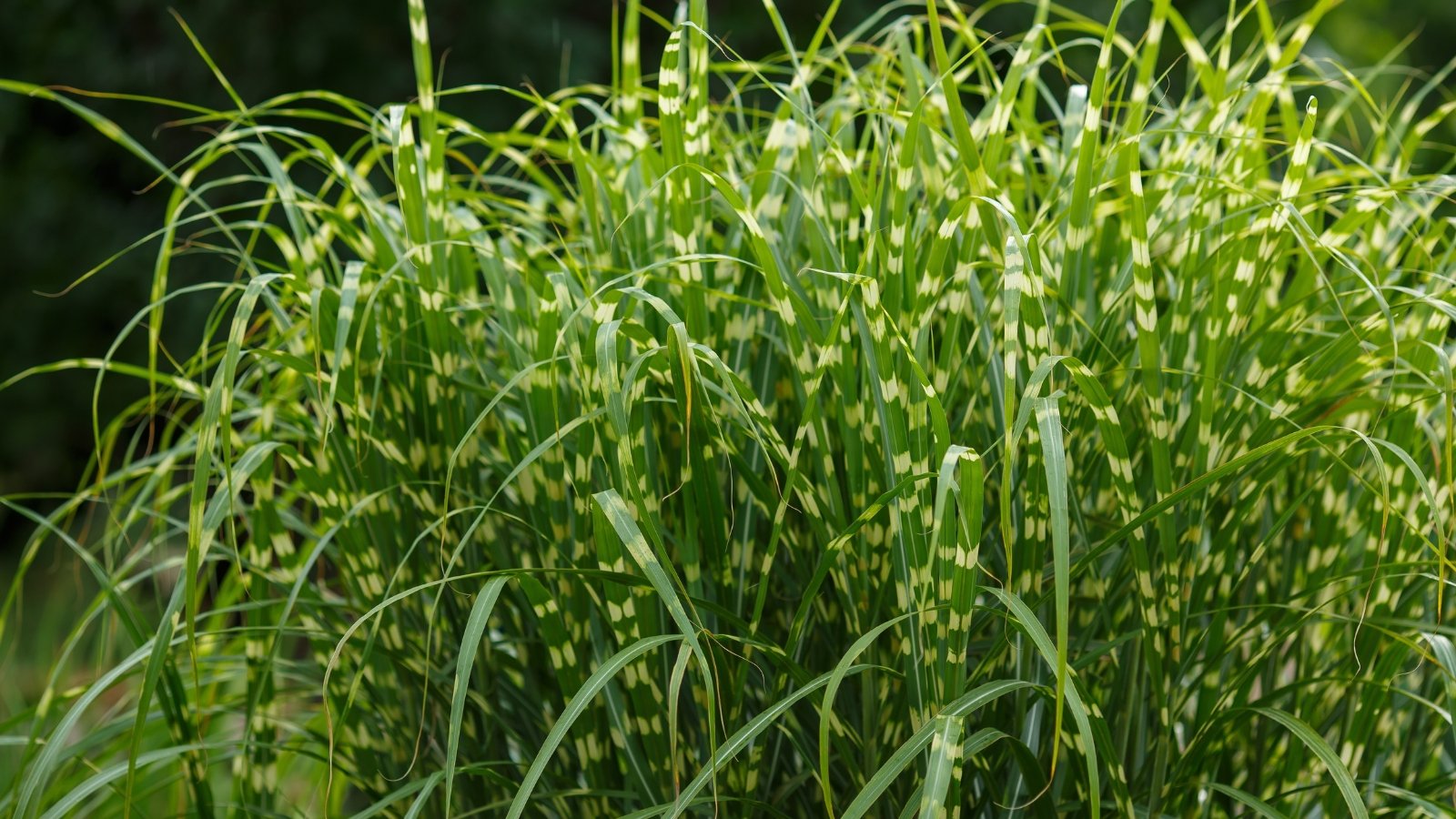
When planning landscaping around a pool, you can’t go wrong with big, beautiful grasses such as zebra grass. This grass can get up to eight feet tall and six feet wide. You could plant one as a statement, or you could plant multiple to create privacy or to break up an area.
Zebra grass will happily grow in partial or full sunlight, and it’s not too picky about soil. Though zebra grass prefers well-draining soil, this plant is also comfortable with soil that gets a bit wet sometimes, which tends to happen near pools.
While this zebra grass cultivar has zebra-like stripes, there are plenty of other cultivars of M. sinensis that you could choose from, available in slightly different colors and sizes. You could even mix and match for a striking effect.
Japanese Maple
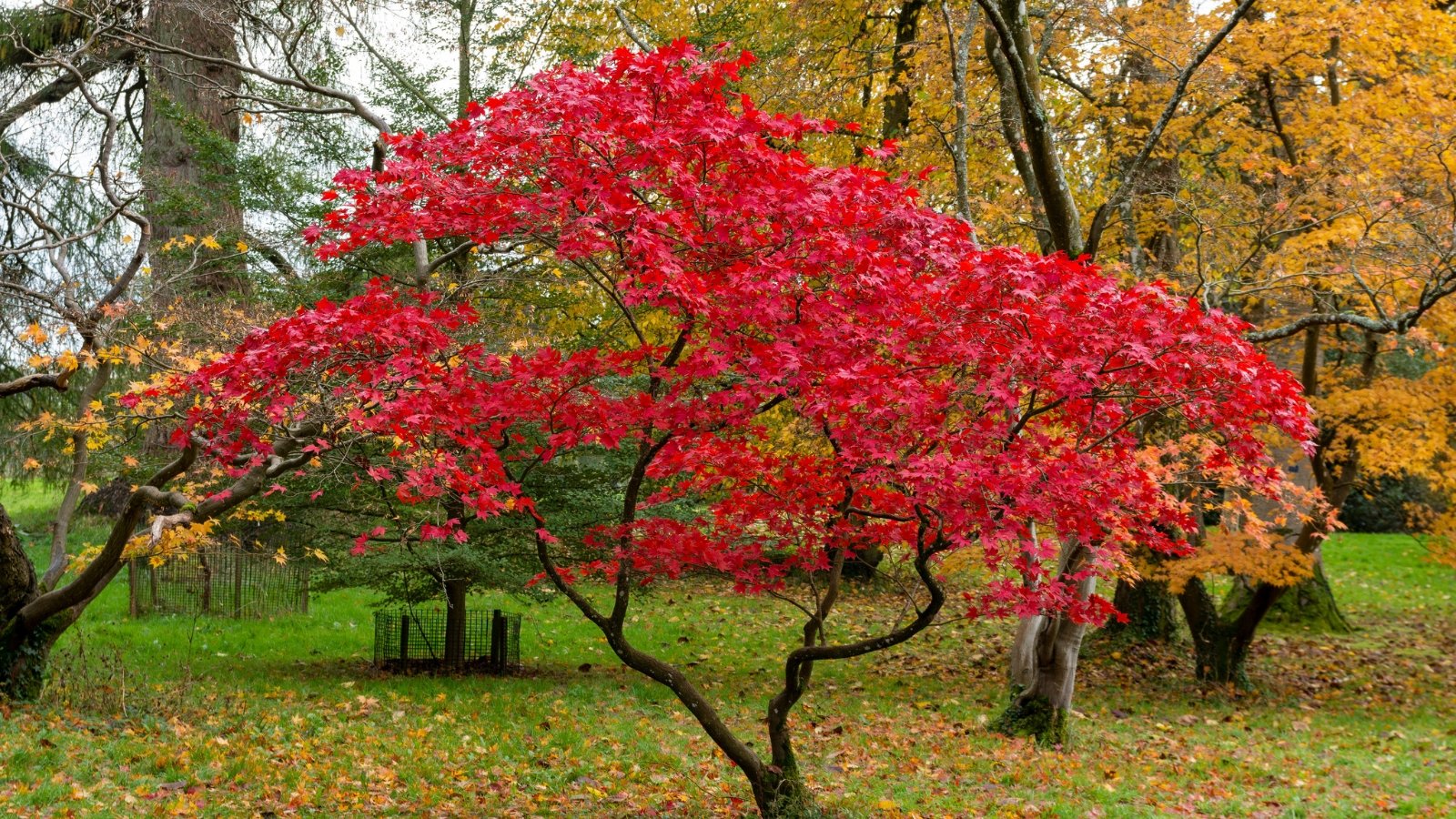
Though it’s certainly not a tropical plant, don’t overlook a Japanese maple tree as a shady option for your pool. While you wouldn’t want to position one so that it overhangs the water, the shade of a gorgeous Japanese maple might be just what you need to cool off in between swims.
These trees like a lot of water and prefer partial shade. Japanese maples reach about only 25 feet in height, so if you have other, taller trees nearby, you could plant a Japanese maple in a spot where the larger tree shades it for part of the day.
Japanese maples are beloved for their often purple leaves and delicate shapes. They can provide eye-catching variety in your pool area among other native temperate trees. There’s also an enormous list of Japanese maple varieties. At least one is guaranteed to suit you.
Canna Lily
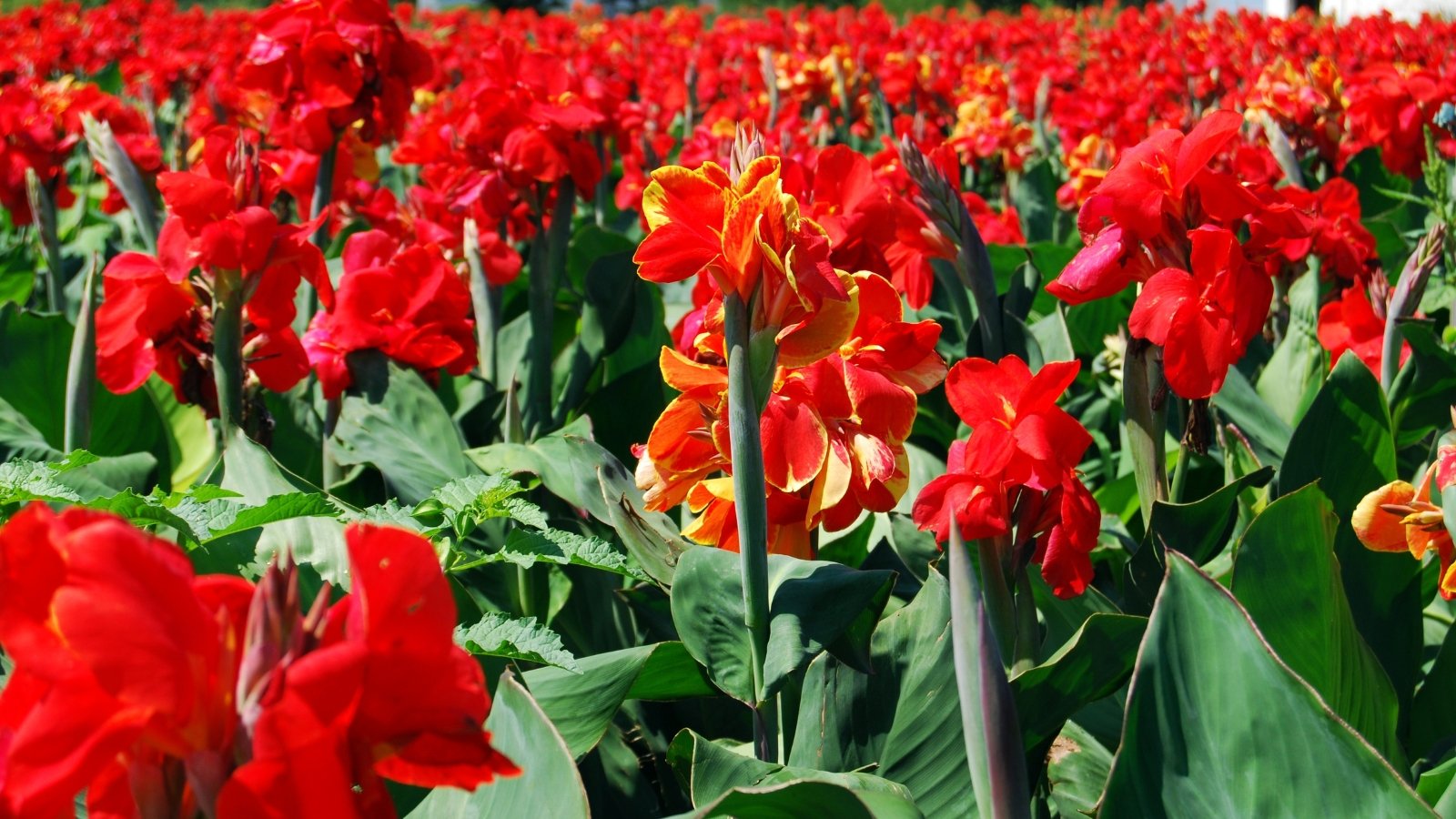
Canna lilies are a type of perennial bulb, but they’re far different from the type of spring bulbs you tend to plant in front of your house. These bulbs grow up to eight feet tall and can get six feet wide, with huge flowers that can be six inches wide.
These bulbs have a tropical look to them, adding to a poolside atmosphere. Their size and the fact that they quickly spread over time makes them another functional option for a privacy fence or to provide shade.
Canna lilies can be somewhat picky. They prefer well-draining soil that’s packed with nutrients, so don’t forget to fertilize regularly during the growing season. Sitting in wet soil for prolonged periods of time can cause their bulbs to rot. That said, they can withstand some splashed pool water from time to time.
Aloe Yucca
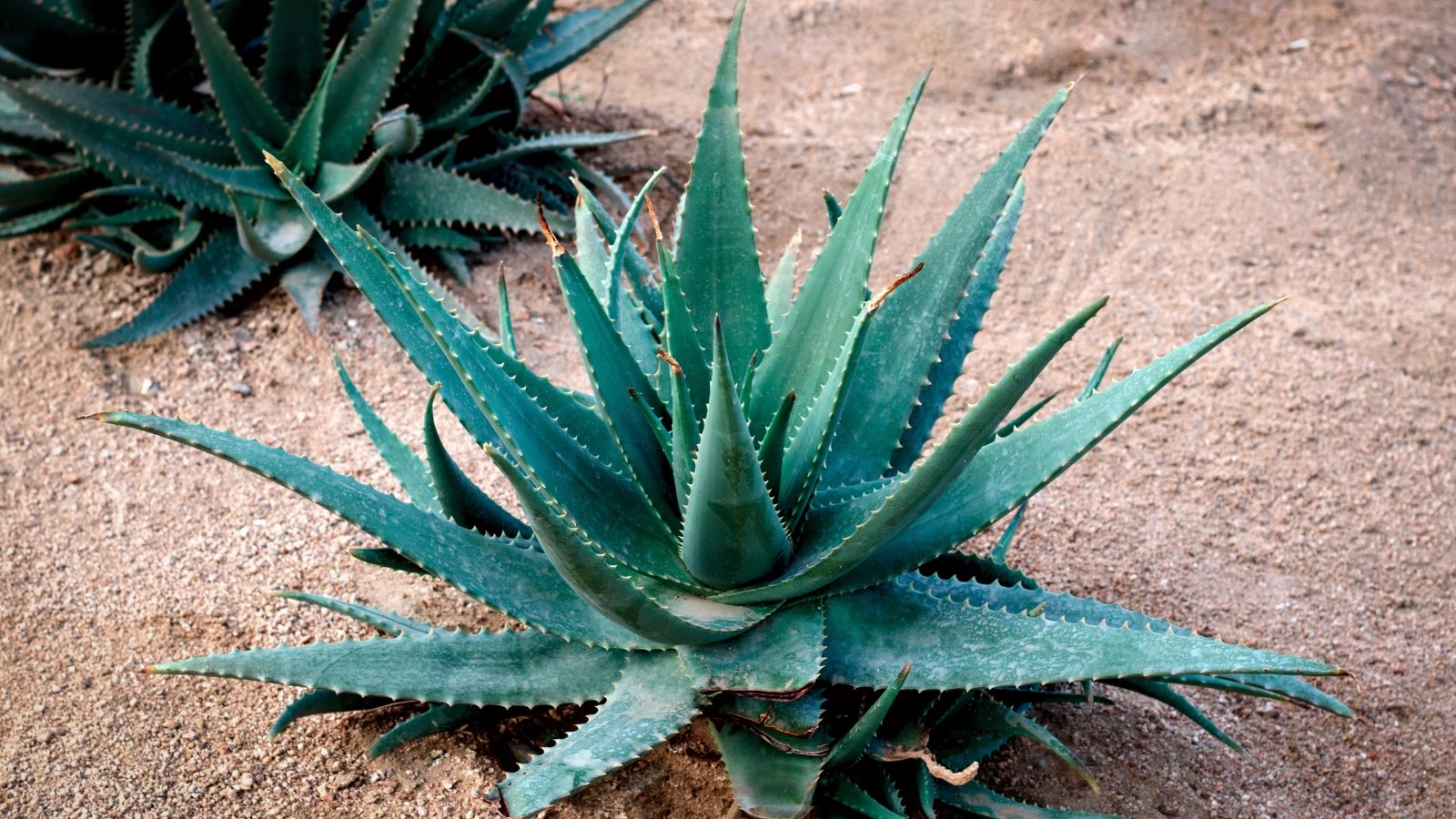
Aloe yucca is another species similar to the Japanese banana tree that looks like it could only grow in hot, tropical climates, when actually, aloe yucca is perennial all the way down to zone 6. It’s the perfect choice for cooler-weather growers looking for a tall, tropical tree.
These trees can grow up to 15 feet tall and have a palm-tree-like growth habit. New leaves form from the top of the plant, while the oldest leaves die off at the bottom, slowly forming the trunk as the plant gets taller and taller.
Aloe yucca plants need very well-draining soil and prefer lots of direct light. Don’t put these plants in regular soil, which can lead to rot. Aloe yucca naturally grows in sandy, dune-like locations, so they’d rather be in super dry soil than moist soil.
Lemon Balm
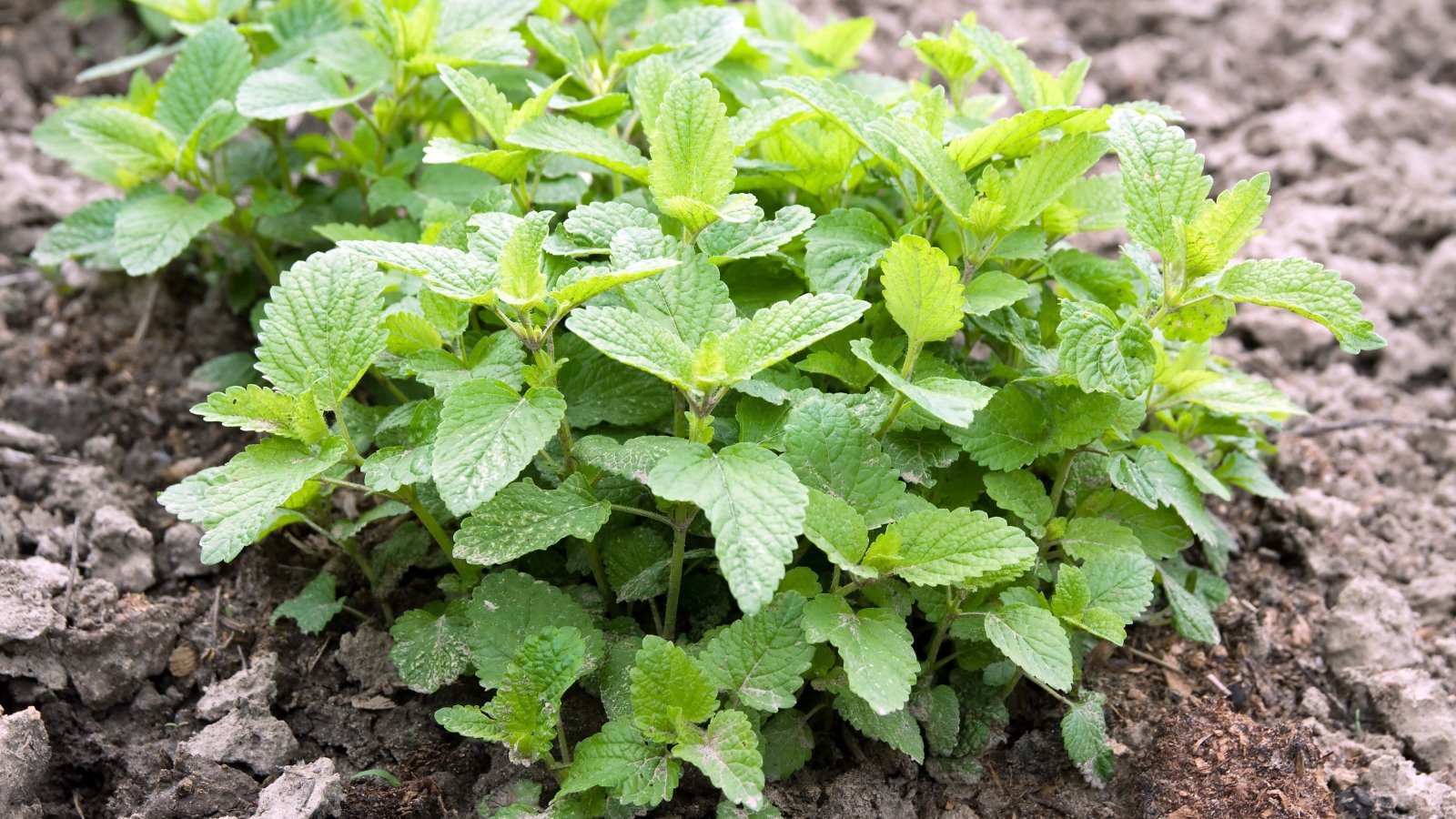
Lemon balm is an excellent herb to grow by the pool or really near any spot outside where you plan to hang out. It’s perfect to plant in a container as part of an arrangement, because the oils from its fragrant leaves are proven to repel mosquitos.
While the mosquitos won’t like it, you’ll probably enjoy the light, lemony fragrance of lemon balm. You can even harvest some of its leaves to make lemon balm tea. Its white flowers, which bloom in summer and fall, will attract hummingbirds and butterflies.
In perennial zones, you can plant lemon balm directly in the ground and rely on it to return again and again. However, avoid doing this if the plant is classed as invasive in your region. It’s in the mint family, and mint plants are notorious for their hardiness. Lemon balm thrives in sunny areas and tolerates most soil types.
Meyer Lemon
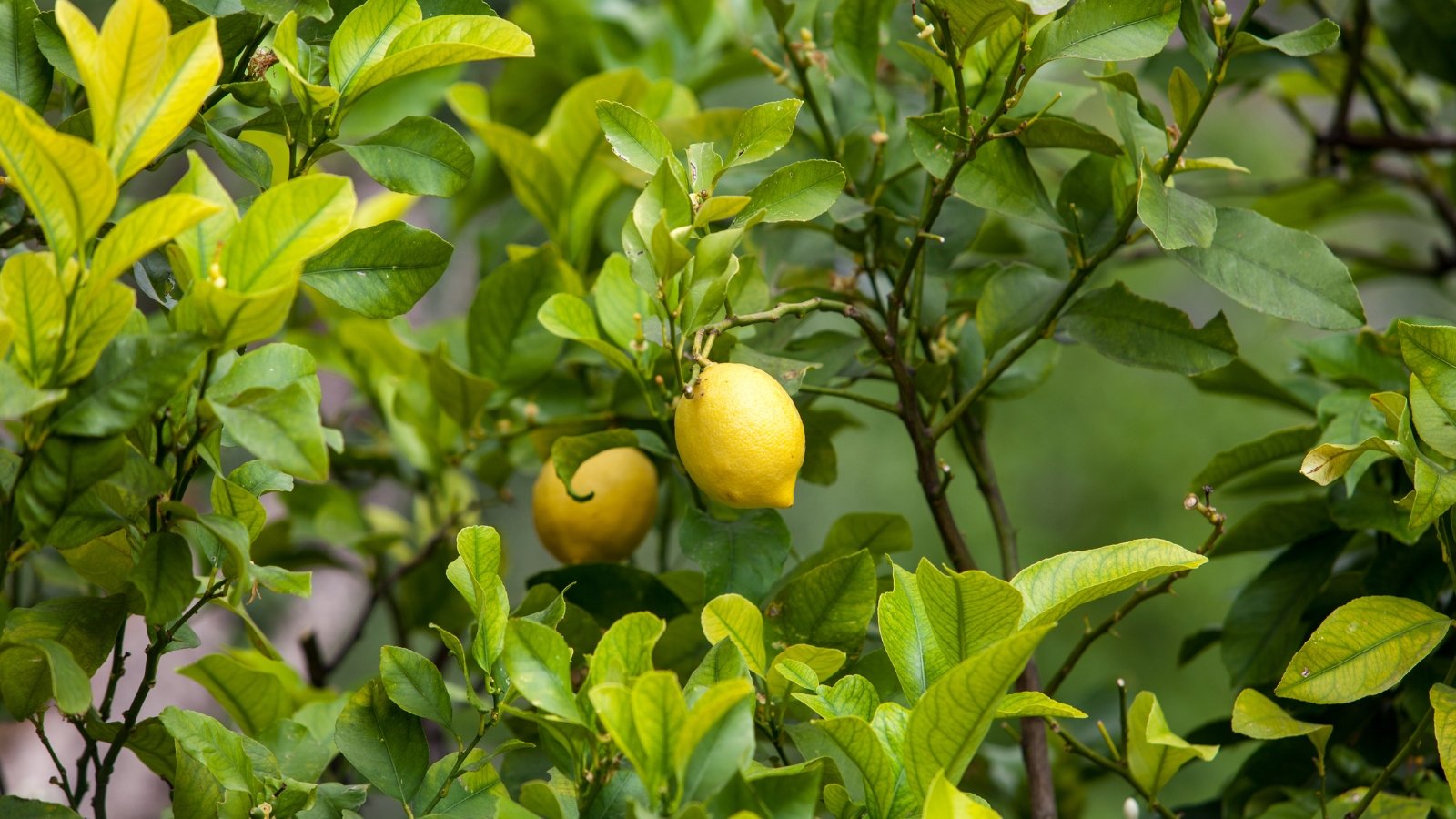
What’s more fun than growing a fruit tree in a pool area? If you grow a Meyer lemon tree, you can pluck your own lemons to make refreshing, poolside beverages. Citrus trees are tropical, adding to the beachy vibe of your pool.
Meyer lemon trees are often grown in containers, so gardeners in cooler zones can simply move their trees indoors when the temperatures begin to cool. In optimal conditions and when kept outside all year, these trees can get up to ten feet tall, but don’t expect that height if you’re growing Meyer lemon as a part-time houseplant.
Plant Meyer lemon trees in good quality, well-draining potting soil that leans acidic. If you’re growing it in a pot, you can even buy a premade citrus soil mix. Give these trees plenty of sun and fertilize on a schedule.
Fountain Grass
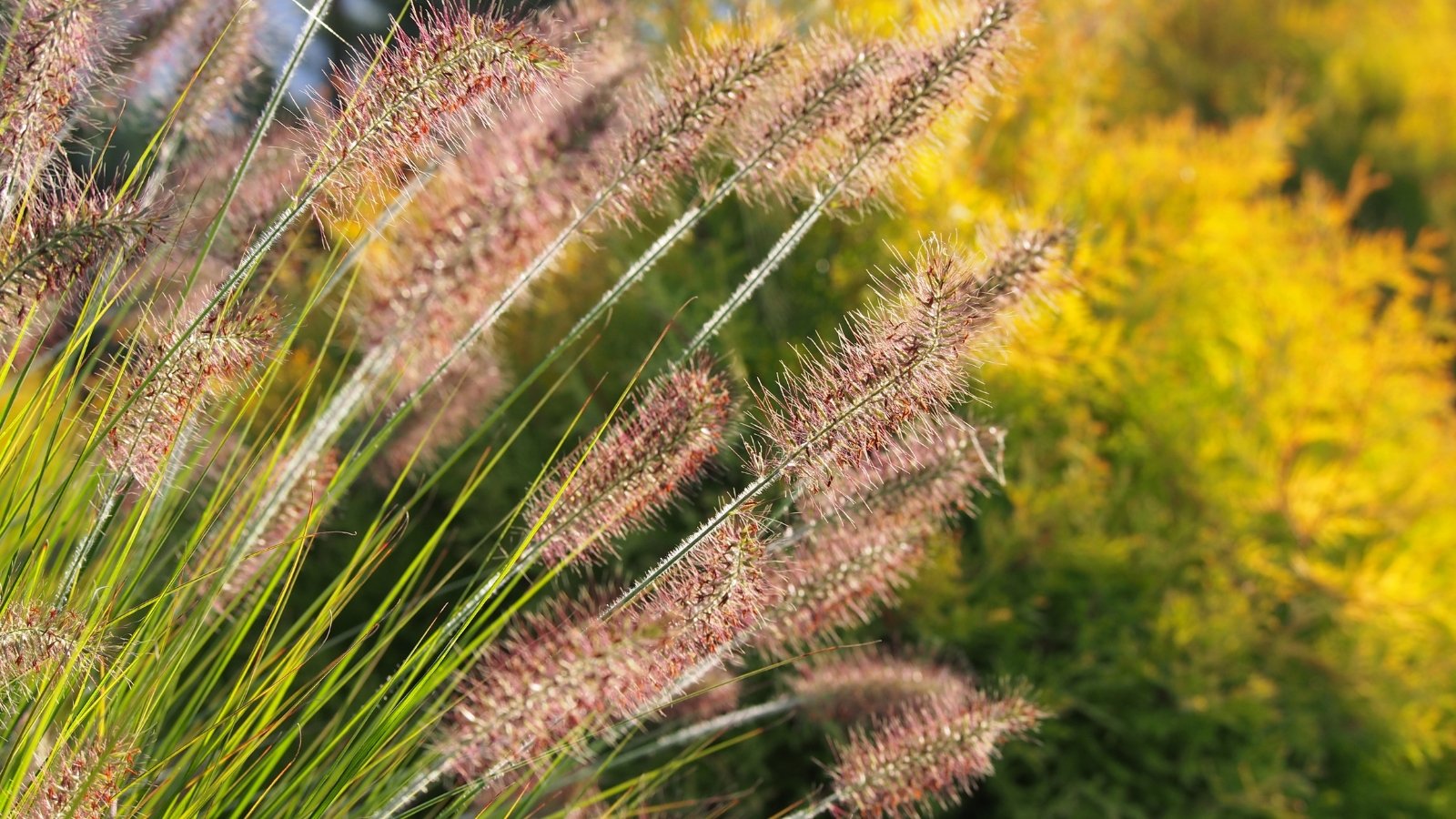
Fountain grass is a clumping, herbaceous grass that grows up to four feet tall and has attractive pink/purple bottlebrush flowers. It’s usually grown as an annual, so why not try out one summer near your pool?
You can plant fountain grass directly into the ground as part of a privacy fence, or you could make it the tall centerpiece in a large container. It adds textural interest among other plants and is super low-maintenance. Note that it is invasive in certain areas, though.
When choosing where to put fountain grass, a sunny spot is best, though ideally, you should plant it downwind. If you plant it in the opposite spot, you may discover lots of fountain grass debris in your water.
Fountain grass is a great choice if your other plants suffer from frequent deer attacks, as deer tend to ignore this colorful grass.
Pineapple Palm
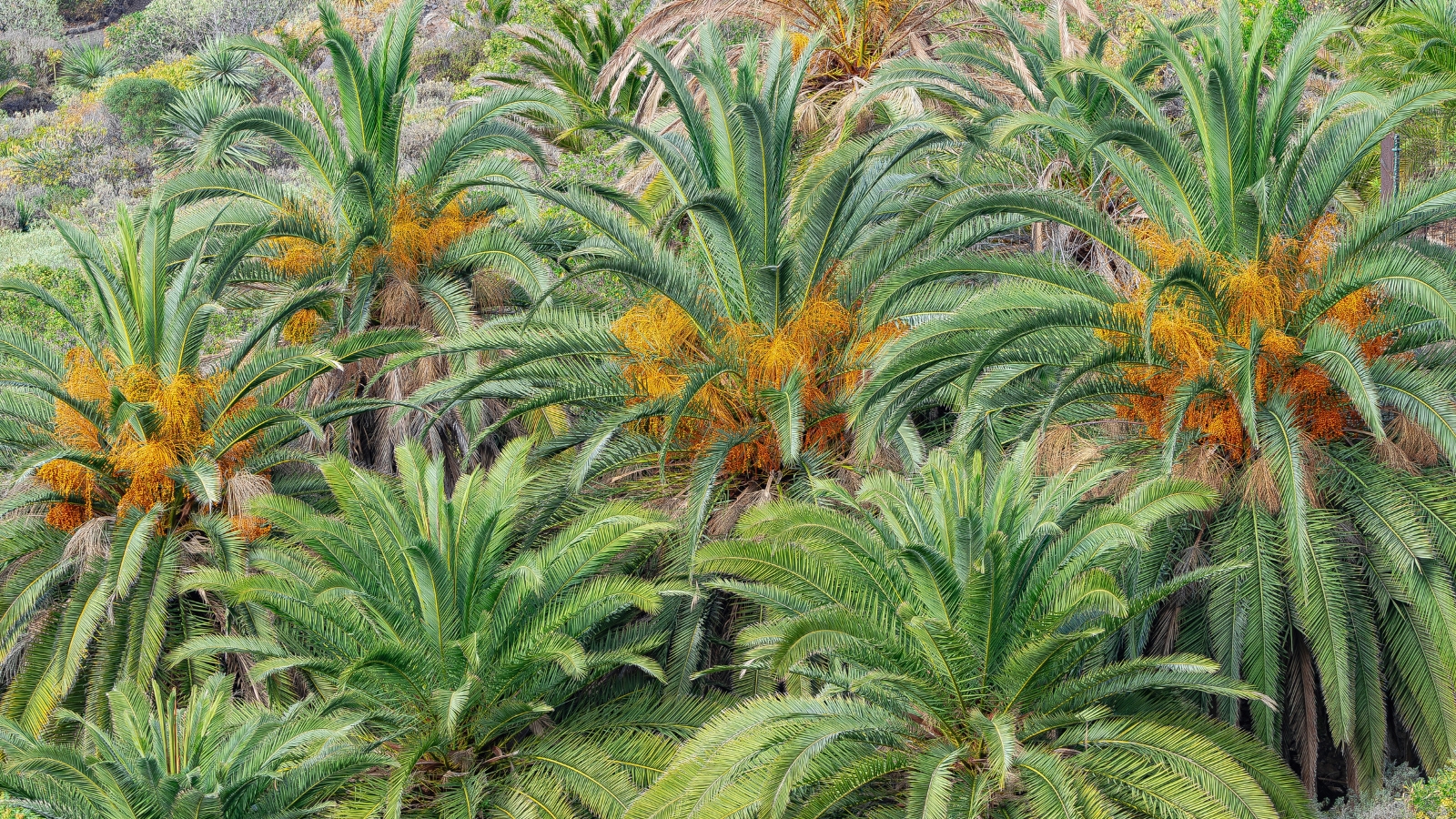
Pineapple palms are striking evergreen palm trees often grown in tropical landscapes, making them a beautiful addition to a pool area. These trees need a lot of space and a lot of sunlight, but if you have it, they’ll reward you with enormous, graceful fronds.
When these trees are young and haven’t grown too tall, they resemble a pineapple with thick trunks that look like the flesh of the fruit. Eventually, in ideal conditions, they can become over 50 feet tall, and they’ll lose their pineapple shape.
It’s possible to grow pineapple palms in large pots, too, but they will eventually outgrow most containers if kept in good health. In cooler zones, you could certainly try caring for a pineapple palm in a large pot. Move it indoors when it’s cool and prune to keep it small.
Plumeria
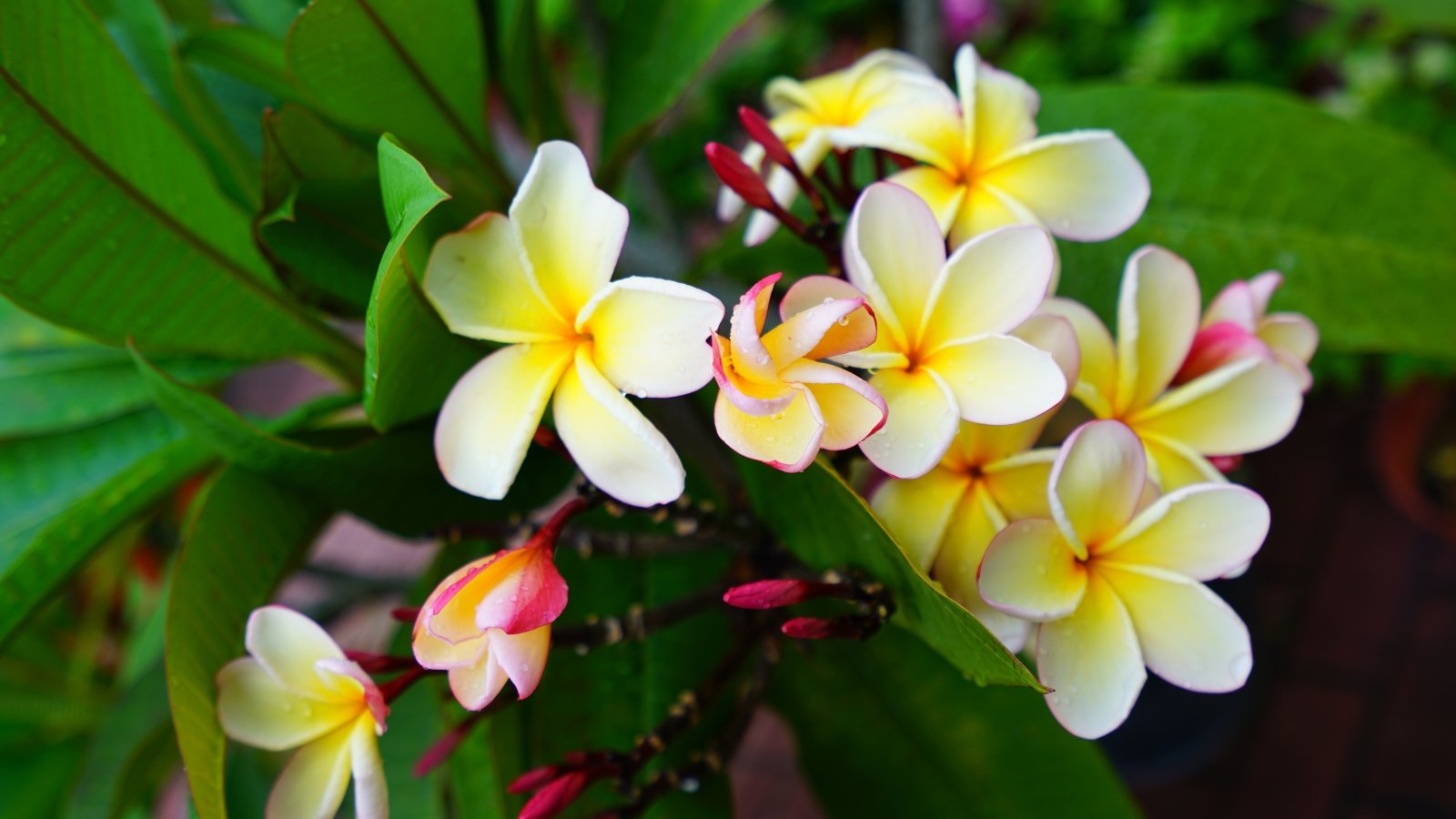
Plumeria plants, also often referred to as frangipani, are small shrubs or trees with eye-catching flowers that look undeniably tropical. If you’re fortunate enough to be in their perennial zone, Plumeria shrubs make wonderful pool plants.
These plants like lots of sun and lots of water. That said, Plumeria species don’t like wet feet, so make sure they’re planted in soil that drains fairly quickly. Different types have different growth habits, but some can get up to 20 feet tall.
The standout feature of Plumeria plants is their flowers, which are extremely fragrant and bloom in shades of pink, white, yellow, and more. The fragrances range between species, but some are citrusy, and some are jasmine-like. The large flowers bloom from spring until summer, and in some areas, they keep blooming well into the fall.
Jade
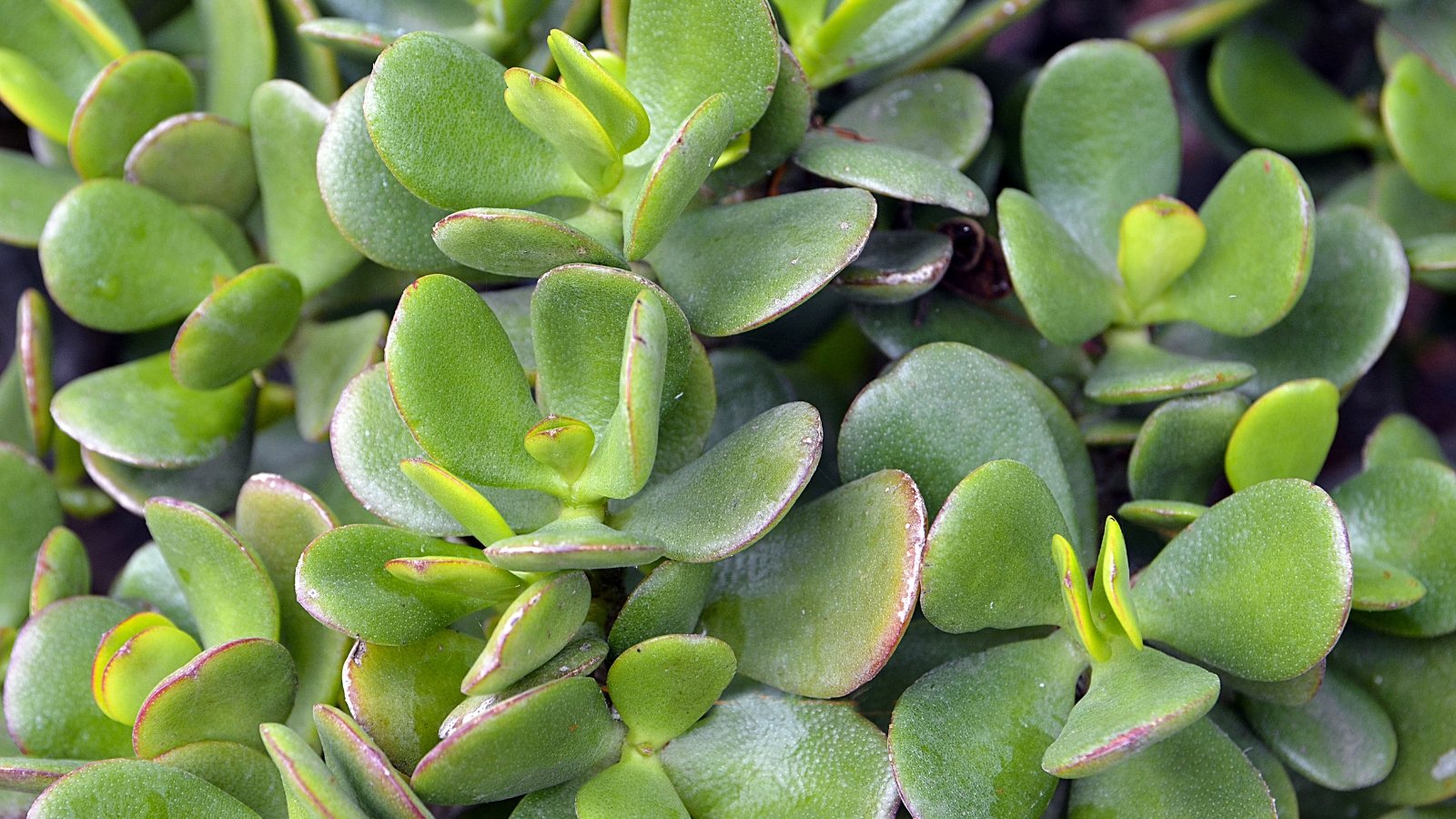
If everything in your pool area is dry except for the pool itself, you can’t go wrong with a jade plant. These classic succulent plants can grow up to six feet tall and add visual interest wherever you plant them. If you’re lucky, they might even flower.
Jade plants will thrive in full sunlight, and they must be planted in well-draining soil. These plants are very drought-tolerant and rarely need to be watered. They’re perfect in dry, arid climates that get minimal precipitation. Do not let them sit in wet soil.
If you’re already growing jade indoors as a houseplant, you can take it outside each spring and then bring it back inside each fall. This will give your plant the boost it needs to stay in good shape through winter while adding to your pool-side scenery.
Lavender
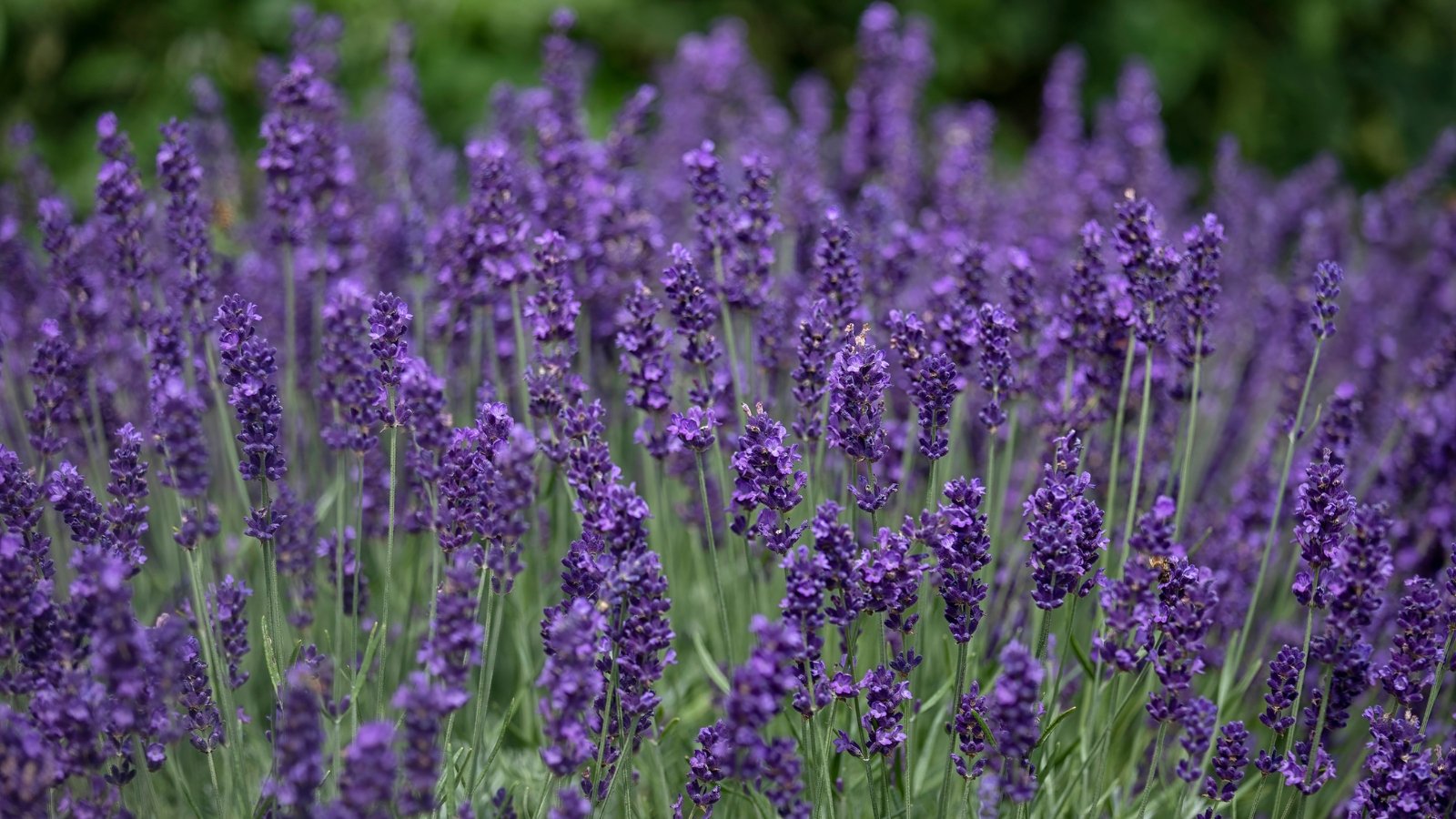
Lavender is a surprisingly good choice to plant around the pool. The oils that comprise its signature scent can deter mosquitos and other flying insects that you don’t want buzzing about when you’re enjoying a refreshing drink on a hot day. Try growing ‘English Tall/Vera’ if you love the smell of old-fashioned lavender.
This herbaceous plant prefers cooler temperatures, so if you’re in a warmer region, you may have to plant it in a cooler spot. Plant lavender somewhere where it’ll get a few good hours of sun, but make sure it gets a little bit of shade. Unlimited UV rays from dawn until dusk are too much for lavender.
Lavender prefers well-drained soil and doesn’t like to sit in water for long. Don’t plant it too close to the pool so that it doesn’t get heavily splashed often. If you’re hoping lavender will return for you next year, prune it in the fall when you’re closing up the pool for the season.
Echeveria
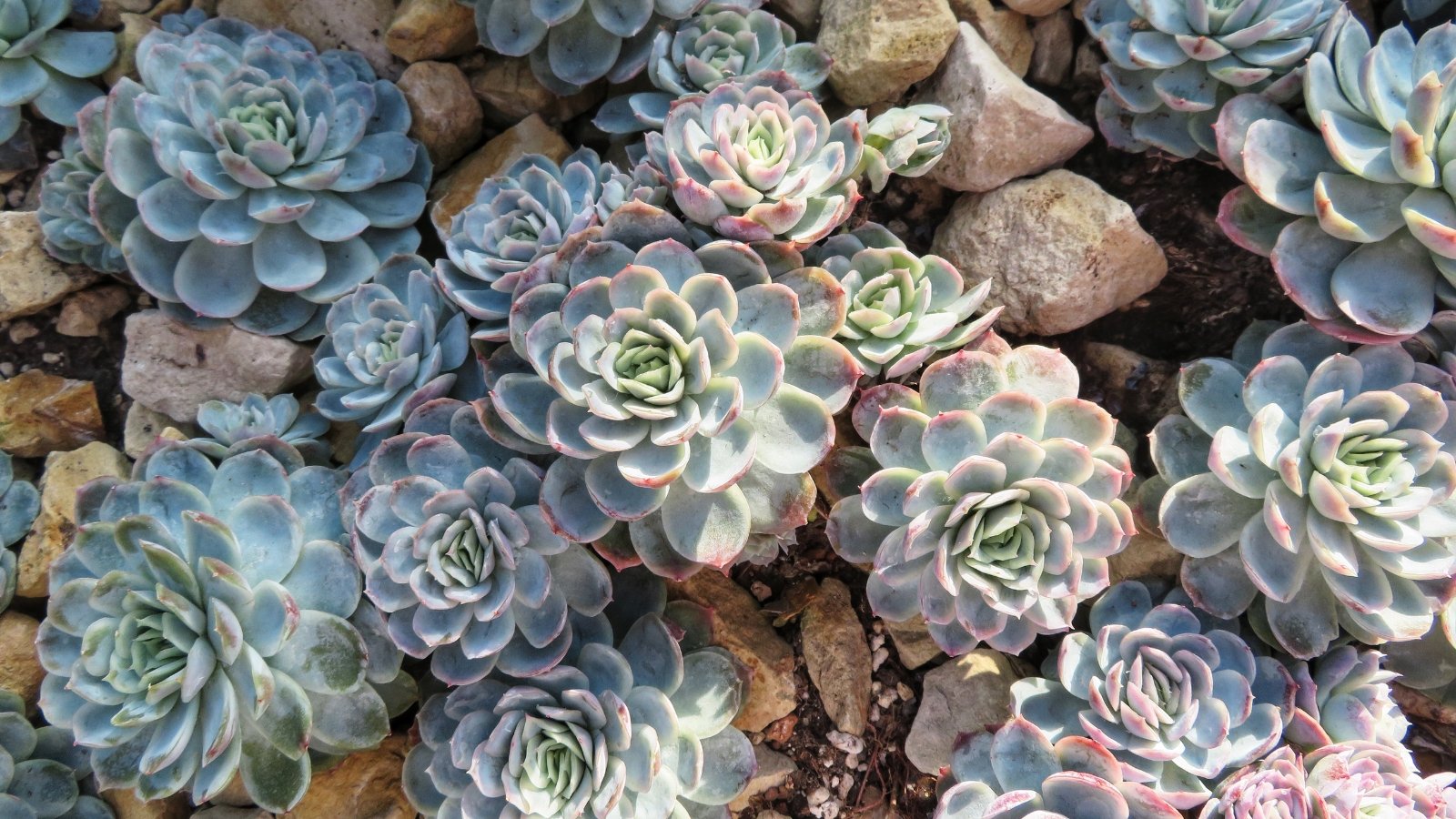
Echeveria is a genus of succulents that love dry, arid conditions and plenty of light. If this sounds like the climate where you live, then you have tons of species to choose from.
Rocky landscapes and xeriscape gardens are the perfect spots for Echeveria, which grow in a rosette shape with plump, succulent leaves. You can find them in an array of pastel shades. They’re super low-maintenance, too.
These succulents will flourish as long as they’re planted in full sun and dry, well-draining soil. Don’t plant your Echeveria too close to the pool, as they won’t appreciate being splashed.
Hens and Chicks
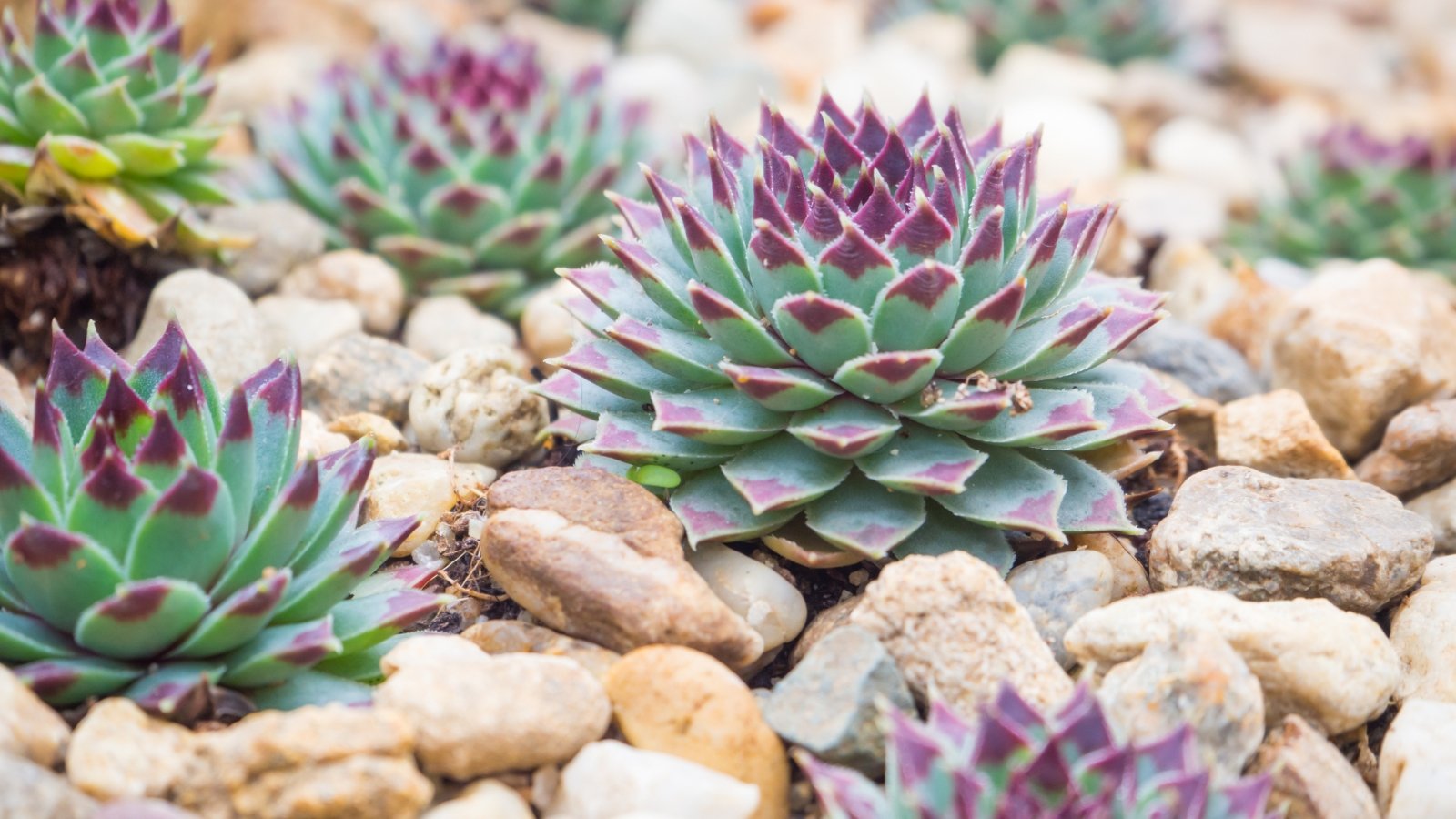
While Echeveria are perennial in zones 9 through 11, Sempervivum succulents, also known as hens and chicks, are perennial in zones 3 through 8. They’re one of the few common garden succulents that survive freezing temperatures.
If you love succulents but don’t live in a warm enough climate to grow them all year, then hens and chicks are your answer. They also grow in rosette shapes and are available in many colors. Grow them away from the pool in well-draining, sandy soil.
Bougainvillea
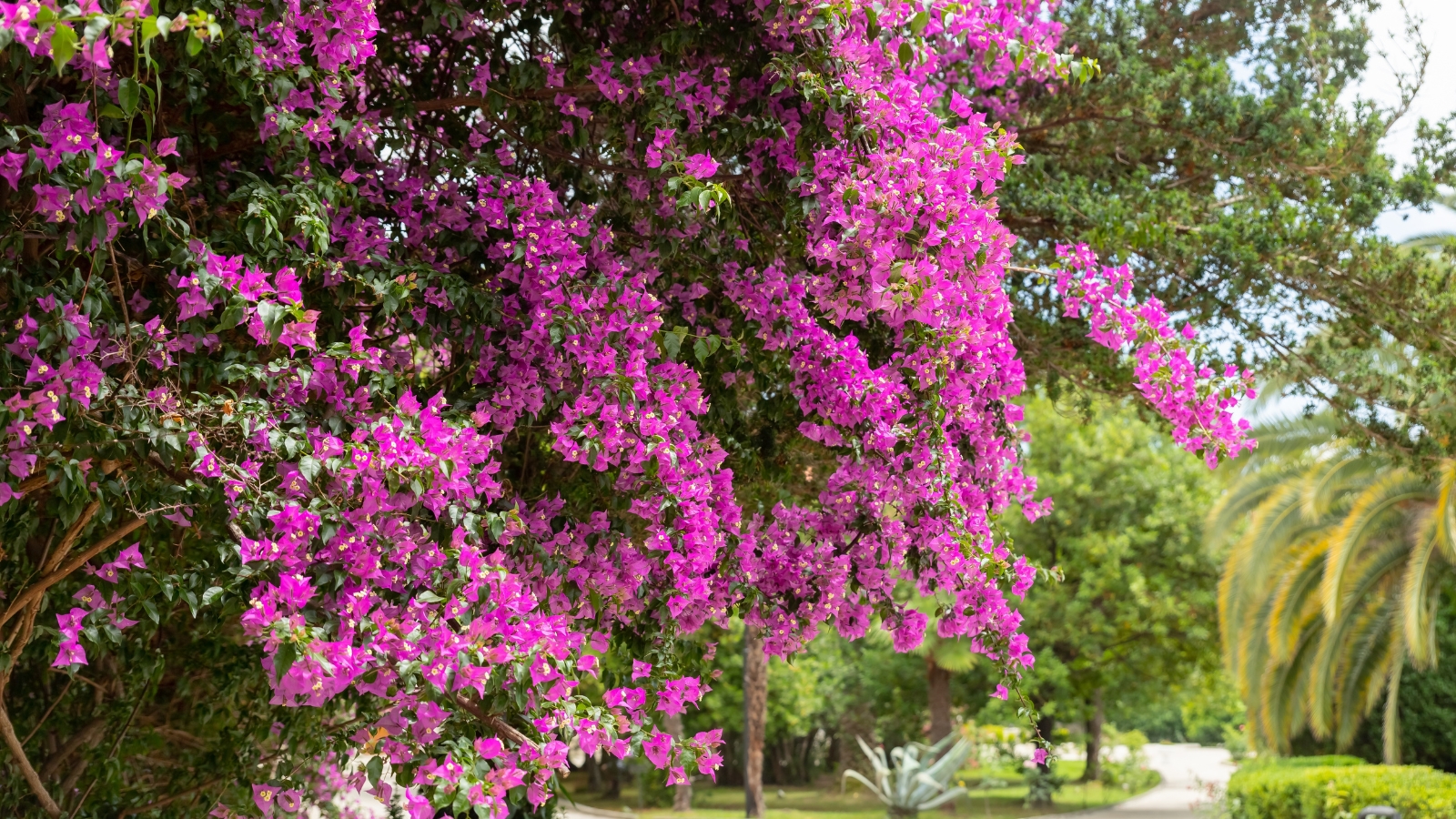
Bougainvillea plants are traditionally grown up trellises, often leaning against a house. Try leaning one against your poolside fence, and you’ll have a beautiful, bright wall of flowers and greenery.
These plants can be a bit finicky. They prefer sandy or loamy soils that drain well, leaning on the acidic side, and they really need full sun to thrive. If you can provide these conditions by your pool, the effort will be worth it.
Bougainvillea species have flowers in shades of gold, pink, purple, red, and white. If you live in a cooler zone where they’re not perennial, try growing them as annuals in hanging baskets.
Aloe
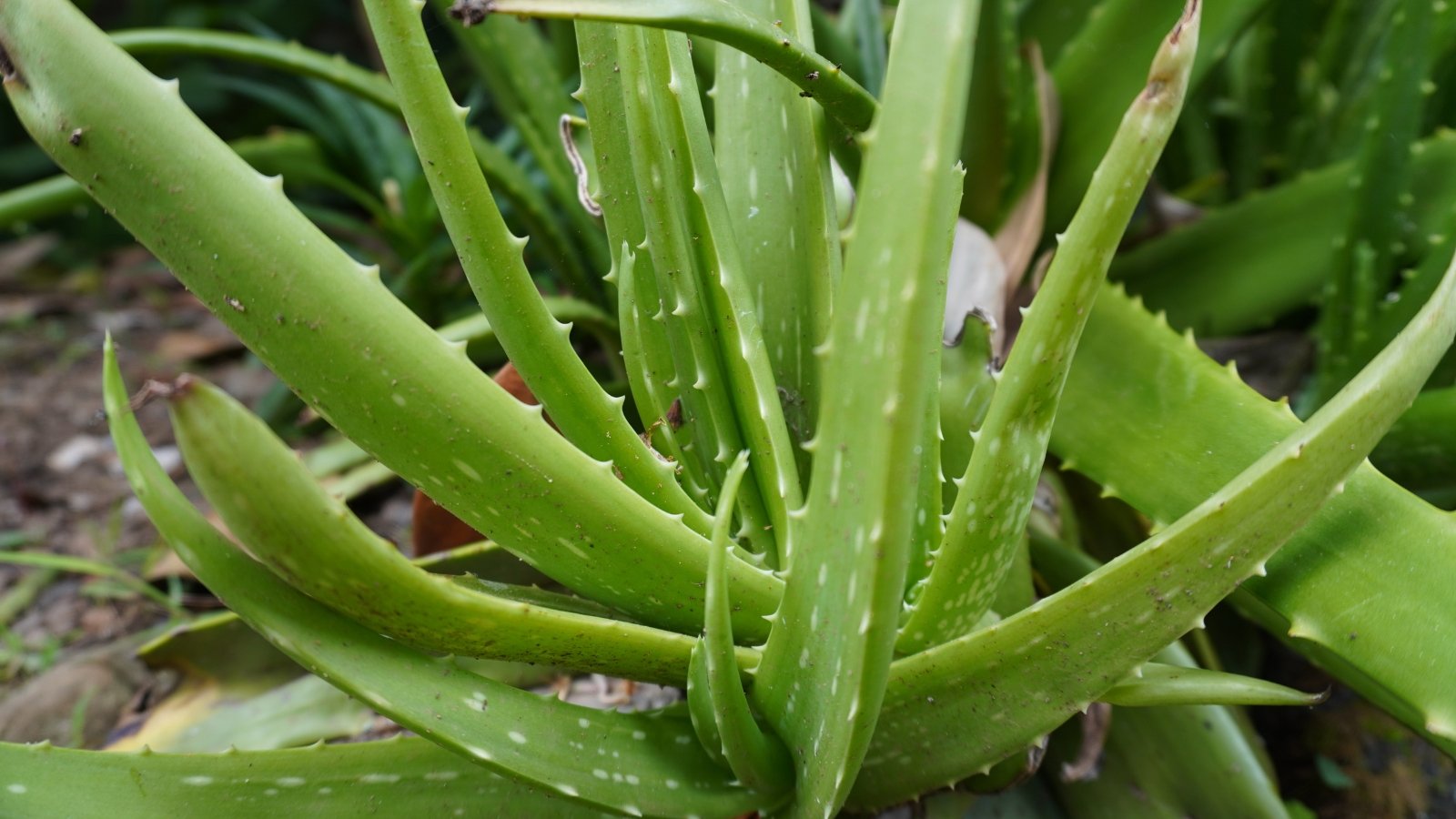
Lastly, don’t overlook an Aloe vera. The logic is simple. People sometimes get sunburnt when they’re swimming or when they fall asleep on a comfy pool-side chair. Aloe gel soothes burns.
If you have a big, healthy Aloe vera plant growing in sandy soil near your pool or in a xeriscape garden, you’ll be ready to snip off a leaf and gather its cooling gel any time.
These plants are only perennial in zones 10 through 12, but they’re mega-popular houseplants as well. In cooler areas, you can bring your houseplant Aloe vera outside as long as nighttime temps are above 50°F (10°C).




